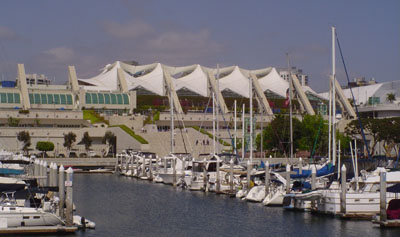 |
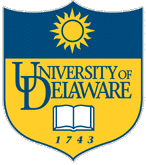 EB2008 EXPERIMENTAL BIOLOGY MEETINGS SAN DIEGO, CA APRIL 5-9, 2008  |
 |
 EB2008 EXPERIMENTAL BIOLOGY MEETINGS SAN DIEGO, CA APRIL 5-9, 2008  |
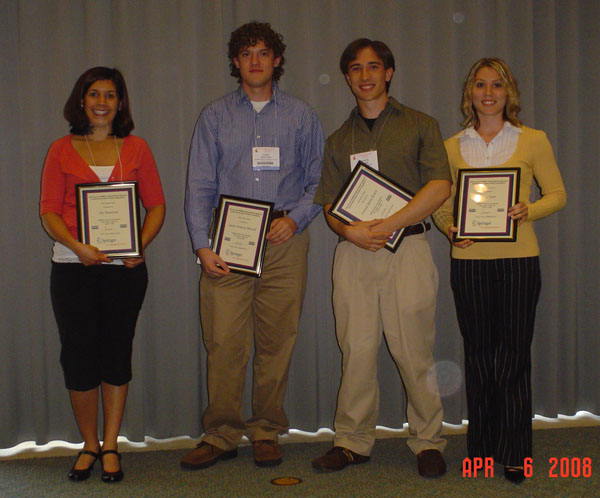 |
Three of the four First Prize
winners in the 12th Annual ASBMB Undergraduate Poster Competition were
students from the University of Delaware. They are Aly Bourreza (left),
Patrick Knerr (second from right), and Krista Neal (right). All three
were also recipients of ASBMB Undergraduate Travel Awards made to the
University of Delaware's Undergraduate ASBMB Affiliate chapter. At the meetings, the University
of Delaware Undergraduate
Affiliate (UAN) Chapter of the American Society for Biochemistry and
Molecular Biology (ASBMB) received the First Annual UAN
Outstanding Chapter Awards for the North East Region and the Nation.
Aly Bourreza serves as the chapter's president. |
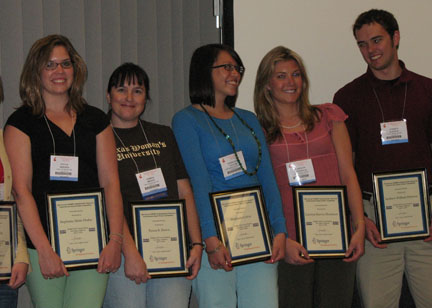 |
 |
| Among the University of Delaware Honorable Mention winners in the ASBMB Undergraduate Poster Competition were Stevie Dreher (left), Stephanie Culver (middle), Carly Dominica (second from right), and Andrew Harmon (right). Vivek Desai and Melissa Warriner were also Honorable Mention winners but are in this photo. | Mark Sausen reciving recognition
as a finalist in the American Physiological Society's Undergraduate
Poster Competition. |
The University of Delaware group included four faculty and sixteen undergraduates.
| Prof.
Hal White Chem & Biochem Prof. Seung Hong, Biol Sci Prof. Gary Laverty Biol Sci Prof. David Usher Biol Sci |
Tyler
Bazzoli Aly Bourreza Owen Brady Stephanie Culver |
Vivek
Desai Carolyn Dominica Stephanie Dreher Nicole Gentile |
Brian
Grindel Andrew Harmon Patrick Knerr Gregory Madden |
Krista Neal Mark Sausen Sergey Sulima Melissa Warriner |
|
|
Identifying
Biomarkers of the
Mhc Gene
Variability
in the highly polymorphic genes of the major
histocompatibility complex (MHC) plays a fundamental role in
influencing the
odor of urinary volatiles in the common house mouse (Mus musculus). To
better
understand the mechanisms underlying MHC-dependent chemosensory
signals, it is
critical to characterize the chemical nature of MHC-dependent odorants.
Urine
samples from MHC-genotyped mice were analyzed using capillary gas
chromatography. By employing multivariate analysis and pattern
recognition
techniques on the chromatographic data, it is possible to classify mice
by
their MHC genotype and to explore which chemical compounds are
biomarkers
capable of discrimination. Soft Independent Modeling of Class Analogy
(SIMCA)
of the data was performed and indicated that the observed genotypes
were easily
distinguishable and well separated, a strong indication that specific
compounds
differentiated the genotypes. Based on the SIMCA model, a graph of the
discriminating power ofto Investigate Chemosensory Discrimination |
|
Recipient of an ASBMB Undergraduate Travel Award, First Place Winner in the ASBMB Undergraduate Poster Competition, President of the outstanding Undergraduate ASBMB Affiliate Chapter |
Evaluating Anti-Androgen
Resistance by In-Vitro Selection
Aly Bourreza and John Koh, Department of Chemistry and Biochemistry Anti-androgens, such as flutamide and bicalutamide (Casodex®), used alone or in conjunction with chemical castration, have been used in the treatment of prostate cancer (PCa) for decades. However, as many as 30%- 40% of patients treated with anti-androgens acquire a therapy-resistant phenotype after one to three years of treatment. Furthermore, some patients experience clinical improvement upon cessation of anti-androgens, a condition known as anti-androgen withdrawal syndrome. Anti-androgen withdrawal syndrome has been associated with mutations to the AR that cause an agonist response to anti-androgens and is one of the most difficult forms of PCa to treat. The goal of this project is to redesign anti-androgens to evade molecular mechanisms that lead to anti-androgen withdrawal syndrome. To accomplish this, novel analogs, PLM1 and PLM6, were developed that remain antagonists towards three AR mutants associated with anti-androgen withdrawal syndrome. In this study, long-term growth analyses of the human LNCaP cell line in the presence of PLM1, PLM6, or bicalutamide have been performed to identify potential AR mutants that would represent an anti-androgen withdrawal phenotype. After approximately 4- 6 weeks, resistant colonies developed and were selected. DNA sequence data of the resistant colonies showed various AR mutations. PLM6 proved to be superior to PLM1 as fewer resistant colonies were observed compared to bicalutamide and PLM1. This suggests that PLM6 may be effective against this form of resistant PCa. This work is supported by the Howard Hughes Medical Institute Undergraduate Science Education program and the National Institutes of Health, NIDDK; 3-R01-DK054257-09. |
 Adam Brady, Muhua Yang, |
Modeling
Tumor
Development: the Role of L1 L1
is a membrane-bound
neural cell adhesion protein involved in the development of the nervous
system. However, L1 has been implicated in
mediating
some of the invasive properties of several cancers including gliomas
and breast
cancers when proteolyzed to create a soluble ectodomain, which then
binds to
cell surface integrin receptors in an autocrine/paracrine manner. L1 has also been shown to rescue cancerous
cells from apoptosis. It was
hypothesized that polyclonal antibodies raised against a 15 amino acid
peptide corresponding
to a critical integrin binding region of human L1 would slow the
migration of
rat 9L/LacZ and human T98 G glioma cells in
vitro, whereas the peptide alone would stimulate migration. Incubation of cells in the peptide decreased
cellular migration, possibly due to competitive inhibition. The effects of the antibody on cell migration
were inconclusive. Quail QT6 cells have
been stably transfected with an L1 ectodomain-Fc fusion protein (L1-Fc)
designed to be secreted into the media. Once
purified, it will be applied to 9L/LacZ and T98 G
cells and
analyzed using automated time-lapse microscopy. Additionally,
glioma cell migration will be analyzed while
on top of QT6
cells secreting L1-Fc. Both conditions
are hypothesized to increase the migration rates of these cell lines by
mimicking the activity of endogenous L1 ectodomains.
Supported by HHMI and INBRE. |
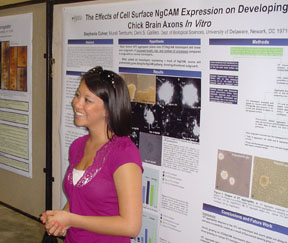 Honorable Mention in the ASBMB Undergraduate Poster Competition |
The
Effects of Cell Surface NgCAM Expression
on Developing Chick Brain Axons In Vitro Stephanie Culver and Deni S. Galileo Dept. of Biological Sciences During embryonic brain development, molecular guidance cues work in concert to transduce signals to guide axons to their appropriate targets. Of these cues are proteins of the Ig superfamily, including L1 and its chick homologue, neuron-glia cell adhesion molecule (NgCAM). L1 and NgCAM are neuronal cell surface membrane proteins shown by others to accelerate axonogenesis and increase axon elongation. In vitro bioassays were performed in order to test the hypothesis that NgCAM expression on the cell monolayer will increase rate of outgrowth, axon length, and number of axon processes. Embryonic Day 7 optic tectum (OT) explants were first used to study outgrowth, yet failed to be an efficient and reproducible model. Aggregates were then made from dissociated OT cells and plated onto NIH3T3 monolayers that did or did not express uniform NgCAM and onto monolayers exhibiting patterned NgCAM expression. The aggregates were visualized using static images and time-lapse microscopy by fluorescent membrane dye. Current data has shown an increase in both axon length and number in the presence of NgCAM, suggesting its crucial role as a positive axon guidance cue. Supported in part by an HHMI Undergraduate Science Education Grant and NIH. |
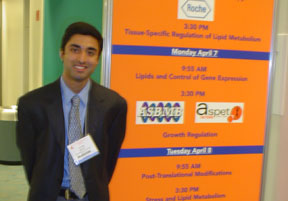 Recipient of an ASBMB-NSF Undergraduate Travel Award. Honorable Mention in the ASBMB Undergraduate Poster Competition Selected for a symposium presentation |
CD44
and Posterior Capsular Opacification (PCO) |
|
Honorable Mention in the ASBMB Undergraduate Poster Competition |
The
Role of N-glycosylation in Drosophila Development: Characterization of
alg10
Proteins
that function extracellularly must undergo the
process of secretion and are subject to posttranslational modifications
before cell signaling can occur. In this
study, Drosophila harboring mutations
in alg10 are characterized. alg10
encodes a glycosyltransferase that catalyzes addition of the
terminal glucose to the growing dolichol-linked oligosaccharide just
prior to its en masse transfer to nascent polypeptides. Our study of
P-element
excision alleles ofalg10
shows that this gene product is of critical importance
during Drosophila development.
Removal of both zygotic- and maternal-derived alg10
results in severe and pleiotropic embryonic deficits, demonstrating the
importance of regulated N-glycosylation during early Drosophila
development. Removal of alg10 from larval eye imaginal discs leads to a
disordered eye of reduced size. These effects may
be mediated through the Sevenless activated MAP kinase cascade, as we
find alg10
mutant eye discs display pathway gain-of-function
phenotypes. These findings indicate that regulated N-glycosylation of a
component of the Sevenless
receptor tyrosine kinase pathway is an important target of Alg10
function. Together, our data suggest that tissue
specific addition of terminal glucose to the dolichol-linked
oligosaccharide is an essential regulatory event in Drosophila
development. Sponsored by HHMI Biological Sciences Education
Program. Carolyn Dominica, Evan Lebois, and Erica Selva Department of Biological Sciences |
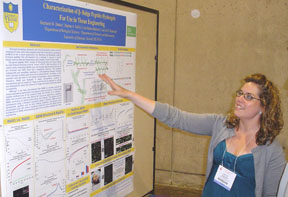 Stephanie Dreher1, Daphne Salick2, Lisa Haines-Butterick2, and1Dept of Biological Sciences and 2Dept of Chemistry & Biochemistry Honorable
Mention in the ASBMB Undergraduate Poster Competition |
Bulk Material Properties of ß-Bulge
Peptide Hydrogels
for Tissue Engineering
|
Department of
Biological Sciences |
Phenotypic Characterization of the 7H24 Mutant in O-xylosyltransferase Formation of
morphogenetic gradients is a fundamental mechanism of developmental
signaling.
Establishment of the gradient dictates how tissues respond to
extracellular
signals to elicit appropriate cellular responses to a secreted ligand.
Recently, we have identified a novel mutation in the
Drosophila O-xylosyltransferase
(oxt) that encodes a key enzyme
required for heparan and chondroitin
sulfate (HS and CS) biosynthesis, named 7H24. In
Drosophila, HS has been
shown to be essential for Wingless (Wg)/Wnt, Hedgehog (Hh) and
Decapentaplegic
(Dpp)/Bone Morphogenic Protein (BMP) extracellular ligand movement and
gradient
formation. When HS is absent downstream signaling of these elemental
pathways
that drive the Drosophila and human
developmental program is disrupted. The 7H24 mutation in oxt
is a functional null and removal of maternal and zygotic oxt is embryonic lethal with terminal
segment polarity cuticle phenotypes suggesting disruption of the Wg
and/or Hh
signaling pathway. Removal of zygotic oxt causes
homozygous mutants to die as pharate adults with small
rough eyes
and thorax defects that cannot close from the pupal case. We find
deficiencies
in Wg, Hh and Dpp signaling in the mutant larval wing imaginal discs
and
evaluation of larval eye phenotypes suggests they do not arise because
of
defects in cell type specification. |
|
Regulation and expression of ERp57 in hepatocellular carcinoma
ERp57/PDIA3, a 1,25D3
binding protein with thiol-oxidoreductase activity, resides in the
endoplasmic
reticulum (ER) owing to a C-terminal QEDL. ERp57 partitions
among cell
surface, cytoplasm and nucleus with functions including 1,25D3
binding,
ion transport, and redox modulation of transcription. A tissue array
immunoscreen of normal and diseased liver sections showed dynamic
changes in
expression in both cytoplasm and nucleus. To understand
expression of
ERp57 in hepatocellular carcinoma (HCC), its steady state distribution
was
assessed in HepG2 cells using: 1) GFP (green fluorescent protein)
tagged ERp57
and, 2) subcellular fractionation. We also measured the response
to
various treatments including PMA, 1,25D3, or TNF-α. High resolution imaging demonstrates
localization of ERp57-GFP in the ER along with additional peri-nuclear
staining. A small (<5%) fraction of ERp57 also exists in the
cytosol.
Co-treatment with PMA, alone and in combination with 1,25D3
for
times from 15´ to 1 h did not reorganize EPp57-GFP. In contrast,
TNF-α
treatment of HepG2 cells moved cytoplasmic ERp57-GFP to the nucleus in
15 min.
Ongoing studies will determine if ERp57 binds to NFkB in HepG2
cells or in normal hepatocytes after TNF-a treatment. These
studies will shed light on redox regulation of transcription by nuclear
ERp57
during TNF-a signaling in
normal and transformed liver cells. Supported by HHMI and the CTCR-UD. |
|
Investigating Human and Drosophila Sprinter Function
Within
developing tissues, the Wingless (Wg)/Wnt signaling pathway acts as a
morphogen, where the extracellular concentration of the Wg ligand
governs the
level of pathway activation in receiving cells.
Regulated downstream target activation within these receiving cells is
essential for proper tissue growth and organization during organismal
development. Our laboratory has
identified a novel highly conserved transmembrane protein in Drosophila named Sprinter
(Srt), which
is required by secretory cells for the release of active Wg ligand
(1).
The specific mechanism of Srt function is
unknown, however without it, Wg is retained and accumulates in the
cells that
produce it. Functional Wg cannot be
effectively disseminated to target cells without complex
posttranslational
processing and packaging (2). Hence, we
hypothesize that Srt functions in the secretion of active Wg ligand by
supplying a critical activity required for maturation of Wg protein in
its
route through the secretory pathway. The
focus of this research is to begin to characterize Srt function and
determine
if the mechanism of function is conserved between humans and Drosophila. Compartment
localization
studies in Srt-Wg co-transfected cells show that the majority of Drosophila and human Srt reside
in an
undefined secretory compartment and high level Srt expression causes
cells to
produce processes that appear to contain vesicles of Wg protein (Figure
1). Furthermore, through
co-immunoprecipitation we have found that Srt exerts its function by
direct
physical interaction with the Wg protein and this interaction is
conserved
across species. These results suggest
that Srt is a multifunctional protein that acts through physical
interaction
with Wg and perhaps promotes cellular morphological changes that
support the
dissemination of functional Wg from secretory cells. This data also
indicates
that these functions are conserved across species. Furthermore, these
experiments provide the foundation for evaluating Srt function and
conservation
in developing Drosophila. |
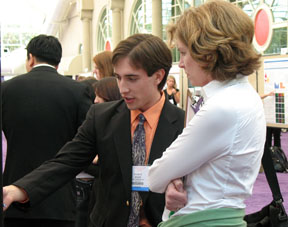 Recipient
of an ASBMB Undergraduate
Travel Award Selected for a symposium presentation |
Metal-triggered
hydrogelation of
self-assembling β-hairpin
peptides
for bioremediation Patrick
J. Knerr, Radhika P. Nagarkar
and Joel
P. Schneider Peptides have been designed which undergo intermolecular self-assembly to form rigid, fibrillar hydrogel networks. These peptides are unstructured and soluble in aqueous solution, but can be triggered to fold into an amphiphilic β-hairpin conformation under specific environmental conditions. Once folded, these hairpins self-assemble to form the hydrogel. Introduction of metal-binding functionality into such a system allows for the development of materials in which hydrogelation can be controlled with particular metal ions. This work reports a β-hairpin peptide incorporating two strategically-placed cysteine residues, known to bind a host of metal ions including arsenic and zinc. Equimolar addition of methylarsonous acid to an aqueous peptide solution triggers folding and self-assembly at low peptide concentration (1.0 wt %). Metal-dependent behavior has been demonstrated using circular dichroism, FTIR, TEM and oscillatory shear rheology. It is envisioned that this system could be responsive to other cysteine-binding toxic metals, such as mercury and lead. Since the peptide sequence includes only natural L-amino acids, this peptide can potentially be synthesized biologically and used for large-scale bioremediation of polluted environments. Funding has been supplied by the Beckman Foundation, the HHMI Undergraduate Biological Sciences Education Program and the NIH. |
|
1Department
of Biological Sciences and 2Delaware Biotechnology Institute
|
Parathyroid hormone
(PTH) mediated shear-induced actin organization and mechanosensitivity
via Ras Homologous A (RhoA) GTPas in osteoblasts
PTH enhances the mechanical loading-indiced increases in bone formation that we postulate results from PTH disruption of the actin cytoskeleton to increase the mechanosensitivity of the osteoblast. Since Ras homologous A (RhoA) GTPase activation promotes action assembly, we examined the effects of these stimuli on RhoA activation, actin organization, and cellular stiffness. Fluid shear (12 dynes/cm2) increases actin stress fiber formation (ASFF) within 15 min in MC3T3-E1 ostepoblasts that is blocked by pretreatment with 50nM PTH. Using a RhoA G-LISA assay, we found that shear activated RhoA within 15 min of the onset of shear and that 15 min pretreatment with PTH significantly inhibited this activation. AFM quantification of the stress-strain relationship of MC3T3-E1 cells indicated that shear produced a 6-fold increase in cellular stiffness that was blocked by PTH pretreatment. Inhibition of RhoA-dependent kinase (ROCK), an effector protein of RhoA with Y27632 blocked the shear-induced ASFF as well as the increase in cellular stiffness. These changes in cell stiffness closely correlated with shear-induced calcuim signaling. These studies suggest that PTH inhibits shear-induced actin organization through the RhoA-ROCK opathway and that the resultant changes in cell stifness play a role in the PTH-mediated enhancement of osteoblast mechanosensitivity. Supported buy an HHMI Undergraduate Science Education Grant and NIH/NIAMS AR043222. |
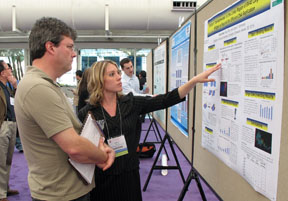 Recipient
of an ASBMB Undergraduate Travel Award,
First Place Winner (Nucleic Acids) in ASBMB Undergraduate Poster Competition |
Identification of
Residues in SV40 Large Tumor Antigen Important for DNA Replication and
Topoisomerase I Binding
Eukaryotic
DNA replication is a vital molecular
process which is not fully understood. Simian Virus 40 provides an
ideal model
system. Its genome encodes the protein large T-Antigen (T-Ag), which
orchestrates the initiation of replication. T-Ag interacts with host
cellular
protein Topoisomerase I (Topo I). Topo I binds a T-Ag monomer at two
sites, one
near the N-terminal domain (residues 83-160) and one at the C-terminal
end
(residues 602-708). Preliminary data suggest that T-Ag's J-domain and
hinge
region residues 101-109, may be involved in Topo I binding. We
generated single
point mutations in full-length T-Antigen and in a N-terminal construct
that
contains residues 62-262. In vitro replication assays identified three
mutants,
N99S, L103Q, and C105F to be replication deficient. Furthermore, DNA
replication was not stimulated by the addition of Topo I, as is WT
T-Ag. ELISAs
showed mutant T-Ags N99S, E100A, L103Q, F104V, and E107G have a
decrease in
Topo I binding as compared to the WT fragment. These data indicate that
this
region is important for Topo I binding and residues N99 and L103 may be
necessary for DNA replication. Other assays will be performed to verify
that
the mutants' deficiency in DNA replication is due to a defect in Topo I
binding
and not to other causes. This work is funded by a PHS Grant from the
National
Cancer Institute to DS and a HHMI Undergraduate Award to KN.Krista Neal and Daniel Simmons |
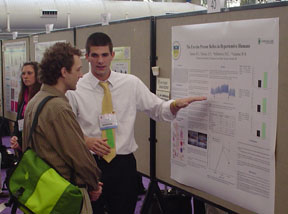 Finalist in the American Physiological Society's Undergrauate Poster Competition |
The
Exercise Pressor
Reflex in Hypertensive
Humans
1Sausen, Mark T., 1Delaney, E.P., 1,2Stillabower, M.E., 1,2Farquhar, W.B. 1 University of During dynamic handgrip exercise (DHE), there is an increase in blood pressure (BP) mediated by “central command” (a neural drive originating in the brain) and the “exercise pressor reflex (EPR)” (a neural drive originating in skeletal muscle). The EPR has been shown to be overactive in hypertensive rats. Purpose: To examine the EPR in hypertensive (HTN) humans during DHE and post-exercise ischemia ( |
|
1Fraunhofer
2Laboratoire National de Santé,
Institute of Immunology, 20A
rue Auguste Lumière L-1950 Luxembourg
Vice president of the outstanding Undergraduate ASBMB Affiliate Chapter |
Expression and
characterization of Loop- and Helix-forming epitopes of Measles Virus
Hemagglutinin in plants
The number of cases of acute Measles Virus (MV) in the |
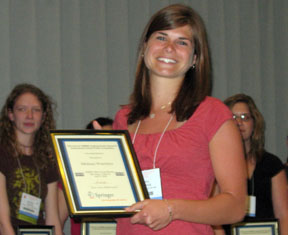
Recipient
of an ASBMB Undergraduate Competitive Travel Award.
Honorable Mention in the ASBMB Undergraduate Poster Competition
|
Gene
Repair in sub-S phase Cell Populations and Cell Cycle: Targeted
nucleotide exchange (TNE) relies on the use of a short synthetic
oligonucleotide (ODN) designed to be
complementary to a target sequence in the genome except for a centrally located mismatch,
which
directs the desired base
change in the DNA. The repair reaction is believed to be enhanced by mechanisms that promote
a more open conformation of the DNA, thus, enabling the target
site to be more accessible for the binding
of the oligonucleotide.
One such method is through the modulation of cell
cycle progression to increase the population of cells in S phase,
wherein
targeting of a single base pair is enhanced. Studies
aimed at demonstrating the variations in
correction in relation
to cell cycle measured repair frequency late in the reaction cycle. Our work aims to discern variations in
repair
levels in sub-phases of S as cells enter and progress through this
phase, in
the presence of the oligonucleotide. In
addition, we evaluate gene expression patterns
of several cell cycle
genes that may help denote the changes
in cell cycle distribution
as a
function of gene repair events. Additional research has been performed
analyzing gene
expression
patterns in malignant versus non-malignant esophageal cancer cells in
response
to treatment with G-rich oligonucleotides (GRO). It has been shown that these
single-stranded DNA molecules
which are comprised
primarily of guanosine residues induce retardation in the progression
of the
cell cycle, and result in a sub-G1
population of apoptotic cells. Successful inhibition of growth of
malignant, but not nonmalignant, cells has been seen.
Thus,
G-rich ODNs may be guiding the selective killing of tumor cells. I am currently analyzing the RNA levels of
apoptosis genes incubated with GROs to understand how the cells are
responding,
and which pathway may be responsible for the induction of apoptosis. Funded by Howard Hughes Medical Institute.
|
The trip to the Experimental Biology
Meetings
in San Diego was organized by the University of Delaware HHMI
Undergraduate
Science Education Program with additional support from travel grants
from
the American
Society for Biochemistry and Molecular Biology, the Beckman
Scholars
Program, and the Women Scholars Program. The HHMI
Program, the Beckman
Scholars Program, Charles Peter White Fellowships,
and the Undergraduate Research
Program
supported research by the students.
 Aly Bourreza explains her poster
to Dr. Ann Aguanno, Corrdinator for
the Northeast Region of ASBMB-UAN
|
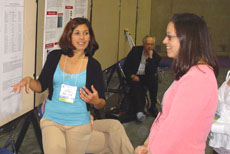 Aly Bourezza Discusses her poster
with Dr. Marilee Benore-Parsons (UD
PhD Chem 1986)
|
 Nicole Gentile talking to Sergey
Sulima and Pat Knerr.
|
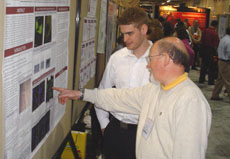 Dr. Usher and Brian Grindel at
Brian's poster.
|
 UD Students at the Old Town
Mexican Cafe enjoying dinner.
|
 Nicole Gentile explaining her poster. |
 Adam and Aly think Sergey has something interesting in his glass. |
 Pat Knerr received his First Prize Award from Dr. Kathleen Cornely. |
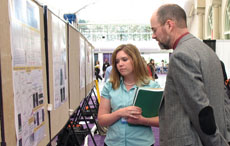 Judge Dr. Paul Craig questions
Stevie Dreher about her research.
|
 That was quite a meal at Osteria
Panevino Italian restaurant in the Gaslamp
District.
|
 Pizza for lunch. |
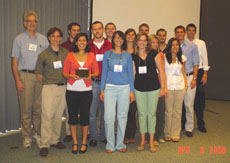 UD Undergraduate memnbers of the
ASBMB UAN Chapter with Dr. White,
adviser, receiving the National Outstanding Chapter Award.
|
 UD Alumni and faculty at Old Town
Mexican Cafe.
|
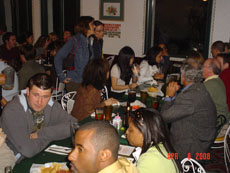 UD students and alumni at Old Town
Mexican cafe.
|
 Just a small section of the huge
number of posters set up each day in
the San Diego Convention Center.
|
 Publisher's Row and other vendor
exhibits in the San Diego Convention
Center.
|
 A break from the Scientific
session for a bit of California sun.
|
 Part of Los Angeles from the air.
If you look closely you can see where
Dr. Usher used to live.
|
 Melissa Warriner answering a
judge's question at the ASBMB
Undergraduate Poster Competition.
|
 Yes, it is still winter in the
Colorado Rocky Mountians.
|
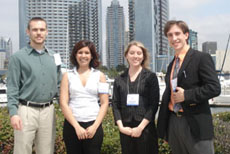 Sergey, Aly, Krista, and Pat at the San Diego marina |
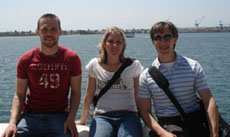 Sergey, Krista, and Pat taking a break from the sessions. |
 Vivek, Sergey, Adam, Dr. White and Pat at the ASBMB Mixer. |
|
 It was at the Las Vegas Airport
that Tyler and Adam deplaned to seek new fortunes.
|
 Santa Catalina Island from the air
as we headed home.
|
 Valley of Fire, Nevada, from the
air on our return trip.
|
 Lake Mead in Nevada was surrounded
by 100s of miles of dry land.
|